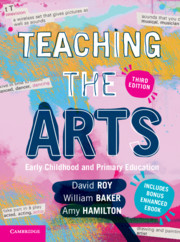Refine search
Actions for selected content:
37555 results in Cambridge Textbooks
7 - Conduction Heat Transfer Analysis
-
- Book:
- Finite Elements for Engineers with Ansys Applications
- Published online:
- 13 September 2020
- Print publication:
- 09 July 2020, pp 476-542
-
- Chapter
- Export citation
1 - The Promise of Multimedia Learning
- from Section 1 - Introduction to Multimedia Learning
-
- Book:
- Multimedia Learning
- Published online:
- 25 June 2020
- Print publication:
- 09 July 2020, pp 3-28
-
- Chapter
- Export citation
Contents
-
- Book:
- Understanding Environmental Pollution
- Published online:
- 25 September 2020
- Print publication:
- 09 July 2020, pp ix-xii
-
- Chapter
- Export citation
About the Author
-
- Book:
- Multimedia Learning
- Published online:
- 25 June 2020
- Print publication:
- 09 July 2020, pp xvi-xvi
-
- Chapter
- Export citation
Some Role Plays
-
- Book:
- Dispute Processes
- Published online:
- 25 June 2020
- Print publication:
- 09 July 2020, pp 331-346
-
- Chapter
- Export citation
15 - Metals
-
- Book:
- Understanding Environmental Pollution
- Published online:
- 25 September 2020
- Print publication:
- 09 July 2020, pp 327-352
-
- Chapter
- Export citation
Index
-
- Book:
- Finite Elements for Engineers with Ansys Applications
- Published online:
- 13 September 2020
- Print publication:
- 09 July 2020, pp 610-614
-
- Chapter
- Export citation
5 - Development of Disputes, Avoidance and Self-help
-
- Book:
- Dispute Processes
- Published online:
- 25 June 2020
- Print publication:
- 09 July 2020, pp 101-122
-
- Chapter
- Export citation
14 - Reflections
-
- Book:
- Dispute Processes
- Published online:
- 25 June 2020
- Print publication:
- 09 July 2020, pp 323-330
-
- Chapter
- Export citation
Further Reading
-
- Book:
- Dispute Processes
- Published online:
- 25 June 2020
- Print publication:
- 09 July 2020, pp 367-392
-
- Chapter
- Export citation
Frontmatter
-
- Book:
- Dispute Processes
- Published online:
- 25 June 2020
- Print publication:
- 09 July 2020, pp i-viii
-
- Chapter
- Export citation
18 - Immersion Principle
- from Section 4 - Principles for Fostering Generative Processing in Multimedia Learning
-
- Book:
- Multimedia Learning
- Published online:
- 25 June 2020
- Print publication:
- 09 July 2020, pp 357-369
-
- Chapter
- Export citation
14 - Persistent, Bioaccumulative, and Toxic Chemicals
-
- Book:
- Understanding Environmental Pollution
- Published online:
- 25 September 2020
- Print publication:
- 09 July 2020, pp 316-326
-
- Chapter
- Export citation
Copyright page
-
- Book:
- Finite Elements for Engineers with Ansys Applications
- Published online:
- 13 September 2020
- Print publication:
- 09 July 2020, pp iv-iv
-
- Chapter
- Export citation
4 - Disputes and Dispute Processes
-
- Book:
- Dispute Processes
- Published online:
- 25 June 2020
- Print publication:
- 09 July 2020, pp 73-100
-
- Chapter
- Export citation
10 - Temporal Contiguity Principle
- from Section 2 - Principles for Reducing Extraneous Processing in Multimedia Learning
-
- Book:
- Multimedia Learning
- Published online:
- 25 June 2020
- Print publication:
- 09 July 2020, pp 227-242
-
- Chapter
- Export citation
7 - Global Warming and Ocean Acidification
-
- Book:
- Understanding Environmental Pollution
- Published online:
- 25 September 2020
- Print publication:
- 09 July 2020, pp 133-165
-
- Chapter
- Export citation

Educational Foundations
- Philosophical and Historical Perspectives
-
- Published online:
- 01 July 2020
- Print publication:
- 29 November 2018
-
- Textbook
- Export citation

Teaching the Arts
- Early Childhood and Primary Education
-
- Published online:
- 26 June 2020
- Print publication:
- 02 July 2019
-
- Textbook
- Export citation

Building and Sustaining a Teaching Career
- Strategies for Professional Experience, Wellbeing and Mindful Practice
-
- Published online:
- 26 June 2020
- Print publication:
- 26 May 2020
-
- Textbook
- Export citation
